When Alaska came to town, we just had to go and see her. Her visits are quite brief, and we didn't know how long she'd be staying. So we piled up in the car in our winter woollies and set off to her mountain residence, the Omalos plateau, the only place where she's accessible to most of us. This is where one of the main attractions of Hania is located (apart from the alluring sun, sea and sand): the Samaria Gorge, a 'must-see' sight for most summer visitors to Crete. After walking downhill for five hours from the Omalos plateau, the Libyan Sea is a welcome sight at Agia Roumeli with its black sand. In the winter, the gorge is closed to visitors (there is a forest guard at the entrance at all times), because Alaska comes to town.
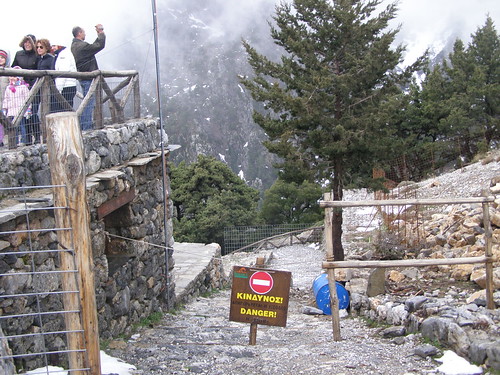
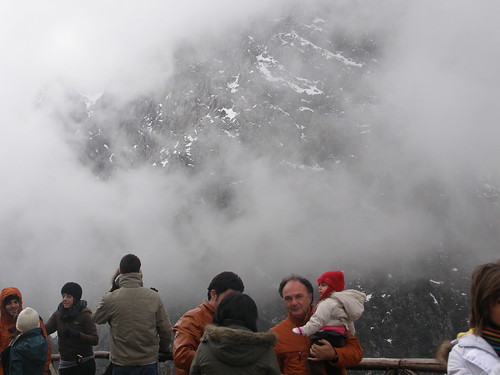
The entrance to the Samaria Gorge is always guarded - the warden's hut is on the left; the cloudy atmosphere is very common in the winter at the entrance to the gorge.
Adverse weather conditions make it dangerous to be in the gorge; at its narrowest point, it fills with water when it rains at dangerous levels, while rocks and stones fall off the cliffs, creating small landslides. Since it became a national park in 1962, no one has been allowed to overnight in the gorge, unless by special arrangement. Only hunters (Mr Organically Cooked among them) and shepherds are experienced enough to access the area after the park has officially closed at the end of summer. I've crossed the gorge once, and would love to do it again, which I intend to do with the whole family.
People around the world go to the snow centre in Dubai, but here in Crete, we don't need to recreate the Alaskan experience artificially. In about half an hour, the Haniotes can see the real thing for themselves. We joined in the madness of the snow hunters just before the Christmas holidays were over. The southerly winds of the past few days had melted the low-lying snow in the valley, but the atmosphere was still that of a white Christmas. It's the middle of winter, and although the Samaria Gorge is closed, the road leading to its entrance is open. The snow ploughs are located in central areas to do their job when they are needed.
To get to the Omalos plateau, you need to drive past the area where we live, past my children's school, past the village where our orange and olive trees are located...
Leaving the village of Fournes; the leaves may have fallen, but the persimmons are still ripening...
... at which point you turn right and start climbing the mountainside, passing through the historic village of Lakki (Lakkous in the accusative)...
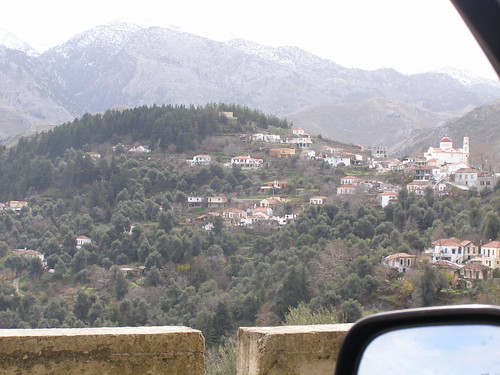
The village of Lakki on our most recent visit
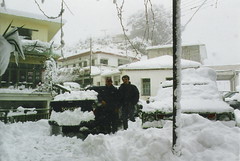
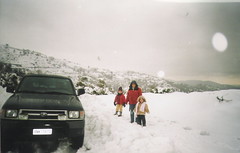
Lakki village in previous years - at this point, the road to Omalos was closed to all traffic.
... and picturesque pine forests...
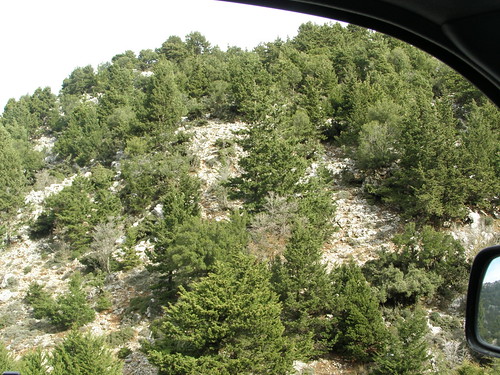
... until you finally reach the Omalos valley, located at a height of 1000 metres above sea level. The road was opened only about 50 years ago and has been widened to such an extent that it is now easy to access the area (as long as it's not snowing).
Visiting Alaska makes you hungry. There are many places to have a good meal along this route. Half the restaurants in the area are tried and true classic purveyors of traditional Cretan cuisine, which they take great pride to announce to their potential customers, through their stone-built premises, wooden fences and old-fashioned names. Many of these restaurants have sprung up on this tourist route relatively recently; they are now seen as the modern trend in measuring economic progress on the island, as they play their role in ecotourism.
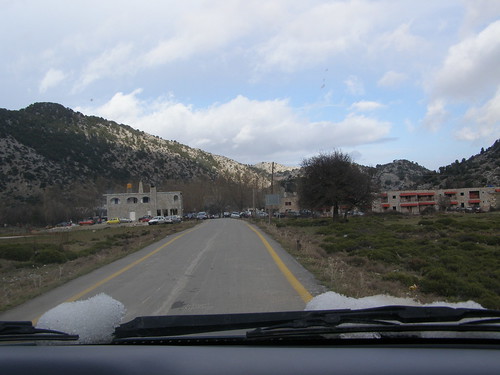
These restaurants and hotels have been renovated over the years - the ones in the photo were the first to cater specifically for tourists visiting the Omalos plateau and the Samaria Gorge.
Only a century ago, the natural landscape of the valley was pretty much void of any sign of civilisation. There were no roads carved in these mountains, nor were there any buildings, except for some stone-built houses used by shepherds. The fields that were being cultivated were planted with wheat: traces of the αλόνι (aloni - where the grain was crushed) can still be seen.
An old aloni behind a former well - this once formed part of a dairy station.
Only when Crete was introduced to more industrialised agriculture did intensive olive cultivation follow, after which came orange and other citrus production, and lately avocado plantations, in the lower-lying regions.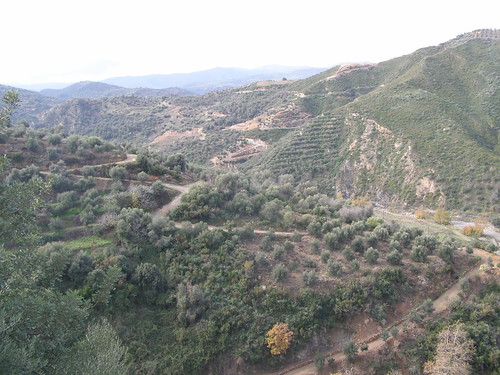
These hills show signs of recent cultivation - the olive trees are very young, they are lined up in perfect rows, and the land has been ploughed or moved mechanically.
The state of the agricultural trade is at present in a shambolic state, due to European Community restrictions and low prices for fresh produce. Olive and orange production are still in full swing, but new ventures that keep pace with the tourist trend in ecotourism, such as summer retreats, restaurants and nature walkways, are being expounded as the new age solutions for the sustainability of the Cretan environment.
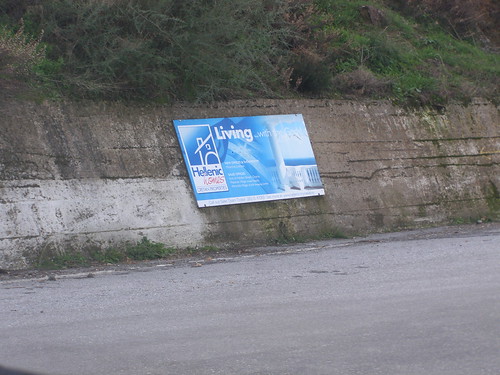
Another sign of 'progress': selling land and purpose-built mountainside homes to retired Europeans, complete with swimming pools - 'living with the gods'?
All the restaurants on the Omalos plateau were doing a roaring trade when we arrived, judging by the number of cars parked around them, the people waiting to be seated and the diners that could be seen from the large windows of the restaurants, none of which should be surprising, given the holiday season and the climatic conditions for this time of year. We decided to give them a miss, making our way back down the mountain and stopping somewhere among the fields in between Lakki and Fournes.
A new restaurant had opened just two months ago: The Botanical Park. One of my husband's taxi-driver colleagues claimed that this restaurant served 'καλό φαγητό' (kalo fayito - good food).
The premises looked rather modern, and the sign at the entrance, painted in bold yellow and green, showed the way to a new road specially built for the restaurant and gardens. It had none of that rustic stone-and-wood look to it that is usually associated with buildings in this area. It even boasted an internet address. After spending half an hour trying to park (the parking spaces should be just enough when the holiday season is over), we entered the restaurant, and were lucky to find a table for four - it was packed with diners.
A (very polite) waiter (they were all wearing modern waitering uniforms with the name of the restaurant clearly printed on it) cleared the table of the last diners' clutter, laid it with paper placemats (oooh, fast food? I thought) bearing the name of the restaurant and left us with some (modern-looking neatly printed) menu cards. I was informed that everything stated on the menu was available, but grilled food may take longer to serve than other meals because it was peak traffic time - 3pm on a lazy holiday Sunday afternoon.
Never have I visited a restaurant in Hania whose waiters work professionally, taking a genuine interest in the customer, making helpful suggestions - and smiling the whole time. Despite the packed house, the food was served promptly, and the presentation was what one would expect from a restaurant in a city centre, working hard to keep customers and build up a clientele. The customers in this case were from the surrounding villages (we recognised a few people), as well as quite a few middle-class townies. The restaurant's fresh outlook (even the plates were square instead of round) is not a pretense to entice you to enter; their whole approach is very modern and competitive.
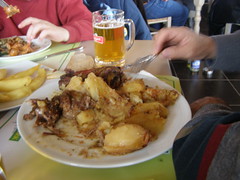
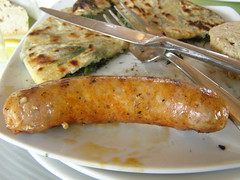
Mr Organically Cooked prefers traditional favorites like roast meat and potatoes, while the rest of us chose some spicier dishes, like peasant-style sausages, marathopites (fennel pies), liver cooked in balsamic vinegar and salad with pomegranate and walnuts.
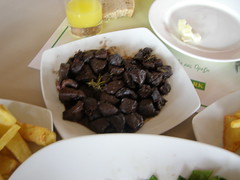

The modern look of the premises - functional square walls and tiled floors - the signage, menu, service, professionalism and respect paid to the environment are all an attempt to break the old-fashioned traditions that have somewhat stifled Hania's reputation in the tourism sector. The outdated atmosphere of the traditional Cretan restaurant owner twiddling his bushy moustache, while his wife (or other family members) does a Cretan jig juggling between kitchen, tables and dishes does not bode well with the transition that the town is required to make to compete with modern Europe for a sector of agro-tourism. The Botanical Park is helping to move Hania's image away from the quainter side of Cretan life, with its well-informed local dwellers showing an interest in providing quality services to visitors.
The menu card boldly expunged most ideas the older generation on the island may have about food: raw wild leafy greens (usually boiled), fruit used in combination with savoury dishes (meat is hardly ever served with cooked fruit), herbs and spices usually associated with tea-making , as well as some dishes not traditionally cooked in Crete at all (like bouyiourdi - Northern Greece - and fried olives - Peloponese). Balsamic vinegar seemed to have replaced the traditional wine vinegar known in the region, and a few 'exotic' dishes were also included, using curry and tropical fruit. The word 'organic' (βιολογικό - violoyiko) featured heavily in the description of the meals. Most dishes used local (Cretan, Mediterranean) ingredients, served up in a new way; new, that is, to the average Cretan and the culinary customs of the island:
<<Το εστιατόριο του Βοτανικού πάρκου Κρήτης συνδυάζει την αναβίωση των παραδοσιακών γεύσεων και προϊόντων με νέες γαστρονομικές προτάσεις.>>
"The Botanical Park restaurant combines the revival of traditional tastes and ingredients with new gastronomic proposals."
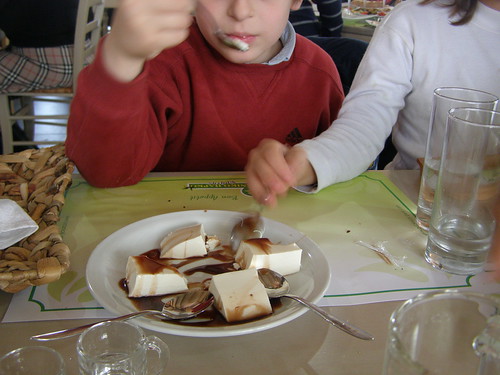
Greek tavernas usually treat customers to a dessert 'on the house' at the end of their meal.
"The Botanical Park restaurant combines the revival of traditional tastes and ingredients with new gastronomic proposals."

Greek tavernas usually treat customers to a dessert 'on the house' at the end of their meal.
In deference to the older generation which have been brought up on favorites which are eaten both at home and when they go out, each menu card included a plain white A4 type-written sheet, headed "Grandmother's kitchen specials"; instead of Mama's taverna, we are now talking about Grandmother's taverna! This is clearly a sign that people are NOT cooking according to the traditional Cretan methods any longer, which also begs the question of whether the Mediterranean diet is being maintained. On a more positive side, the fact that these dishes were not included in the main menu and were hastily written up in the addendum shows that people are still expecting to see solidly staple Cretan dishes, which is why the restaurant owner felt obliged to offer them. The specials included traditional roast lamb and potatoes, pork and celery, and vegetarian xinohondro with eggplant; in the summer, I would expect to see boureki, snails and yemista listed there. My own family's meal choices came from that page.
There has indeed been some attempt to create a botanical park in the area (as the name suggests), but the plants are too small at the moment to make a distinguishable impression on anyone at this stage. Besides, it was raining, making a walk through the area with young children too tricky to handle. But the view was worth taking in from the wide balconies (perfect for the summer months), making it a good place to visit all year round, a very important factor given that most places in Hania operate on a seasonal basis. The restaurant isn't far from our house (a 20-minute drive), and I can't wait to take some friends there (perhaps you?). Nouveau cuisine has finally entered the traditional staunchly old-fashioned market of the Cretan restaurant trade.
We ordered a green salad, a plate of (4) peasant-style sausages, 2 large fennel pies cooked on the hob, 2 servings of fried potatoes cooked on the hob, fried liver in balsamic vinegar sauce, and a (rather large) serving of roast lamb and potatoes cooked in a wood-fired oven. Cost: 43 euro (the drinks were shouted - Kiwi slang - by friends).
*** *** ***
As we were leaving the restaurant, I asked the owner about the website mentioned on the restaurant sign. He admitted that it wasn't operating yet, but it would be up and running in a couple of weeks. I told him about my website which he seemed to show some interest in.
"Leave me your contact details" he asked. I wrote my name, website, and email on a piece of paper.
"Verivaki?" He looked up at me, eyes wide open with surprise. "Are you from Lakki?"
It's a nice feeling to be known by your name, as it gives you a sense of belonging, something I didn't really have until I came to live in Crete.
*** *** ***
Here's my version of the fantastic salad I ordered at the Botanical Park restaurant.
You need:
some torn lettuce leaves (locally grown)
some torn tender baby spinach leaves (locally grown)
some torn rocket leaves (locally grown)
the seeds of a pomegranate (locally grown)
a few shelled walnuts (the fresher and the more locally produced, the better)
some of your favorite cheese, cut into small cubes (halloumi was used at the restaurant, I used blue vein, but feta, Cretan graviera or mizithra from Hania would also work very well)
a few drops of balsamic vinegar (there is a locally made variety in Hania)
a few drops of olive oil (needless to say, local!)
NO salt - the cheese already contains plenty of it!
Wash and drain the greens very well. Pick out the seeds of the pomegranate. Place all the ingredients in a shallow dish, toss well and serve. If you're not a vegetarian, this salad goes extremely well with dry-cooked meat such as spicy sausage or fried liver. Alternatively, some thinly sliced prosciutto would blend well with the colours and the taste.
This is my entry for this week's Weekend Herb Blogging, hosted by Rachel from The Crispy Cook. Weekend Herb Blogging focusses on flowers, herbs and vegetables used in unusual ways in recipes. In this salad, all the ingredients deserve a special mention; leaving aside the greens, the fruity taste of the walnuts and pomegranates make a unique contribution to this amazing salad, featuring some of the best seasonal tastes of Crete. All the ingredients were locally sourced.
You need:
some torn lettuce leaves (locally grown)
some torn tender baby spinach leaves (locally grown)
some torn rocket leaves (locally grown)
the seeds of a pomegranate (locally grown)
a few shelled walnuts (the fresher and the more locally produced, the better)
some of your favorite cheese, cut into small cubes (halloumi was used at the restaurant, I used blue vein, but feta, Cretan graviera or mizithra from Hania would also work very well)
a few drops of balsamic vinegar (there is a locally made variety in Hania)
a few drops of olive oil (needless to say, local!)
NO salt - the cheese already contains plenty of it!
Wash and drain the greens very well. Pick out the seeds of the pomegranate. Place all the ingredients in a shallow dish, toss well and serve. If you're not a vegetarian, this salad goes extremely well with dry-cooked meat such as spicy sausage or fried liver. Alternatively, some thinly sliced prosciutto would blend well with the colours and the taste.
This is my entry for this week's Weekend Herb Blogging, hosted by Rachel from The Crispy Cook. Weekend Herb Blogging focusses on flowers, herbs and vegetables used in unusual ways in recipes. In this salad, all the ingredients deserve a special mention; leaving aside the greens, the fruity taste of the walnuts and pomegranates make a unique contribution to this amazing salad, featuring some of the best seasonal tastes of Crete. All the ingredients were locally sourced.
My father's grandfather (my great-grandfather) was from Lakkous, while the Verivakis name continues to be linked with the military and politics.
©All Rights Reserved/Organically cooked. No part of this blog may be reproduced and/or copied by any means without prior consent from Maria Verivaki.
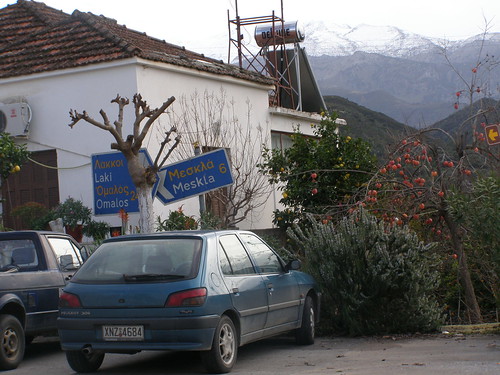
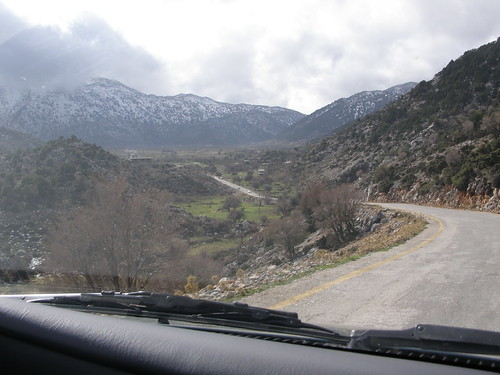
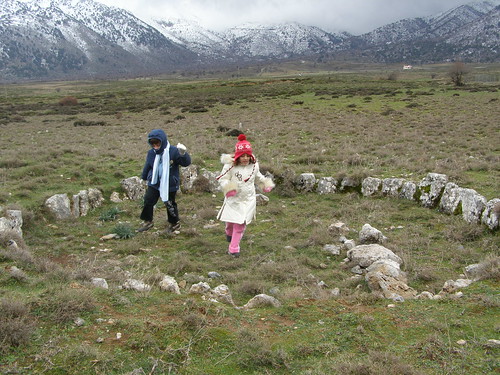

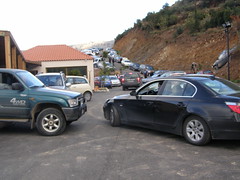
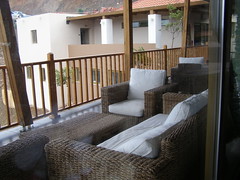
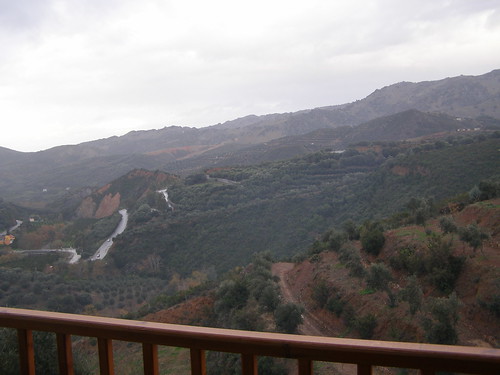
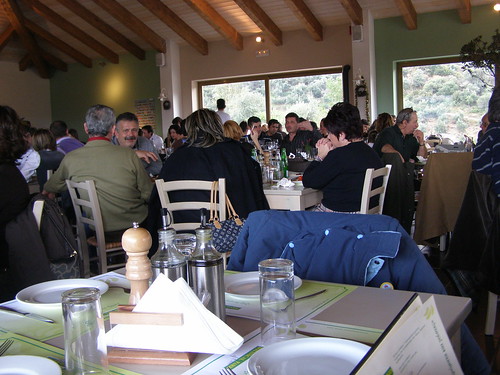


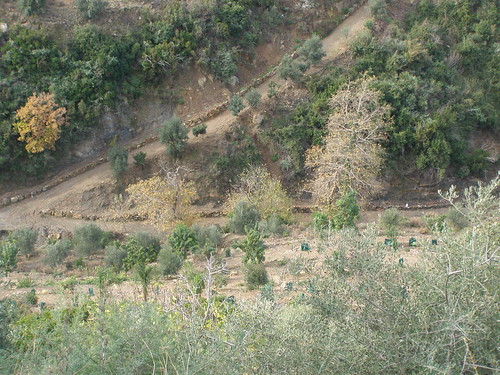
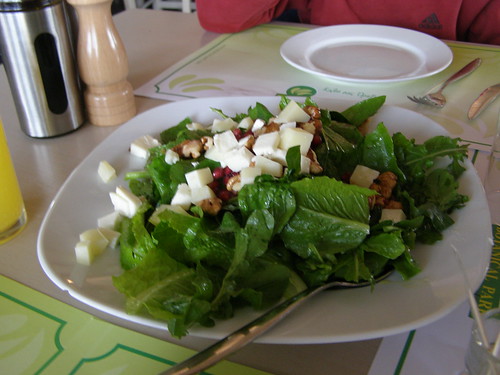
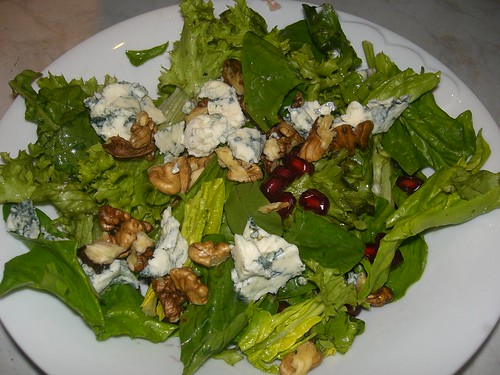
I love these travel and history pieces you write. It's like taking a trip along with you and your family. This salad sounds like a lovely blend of tastes. Thanks for sending it off to Weekend Herb Blogging.
ReplyDeleteAnother wonderful field trip...I want in! The loukaniko looks yum, plates of fries, Cretan beer brand I've not heard of and that glyko...a panna cotta of some sort with Petimezi?
ReplyDeleteI think your salad's better with the roquefort.
What a marvelous excursion! An ambitious undertaking for the restaurant, nouveau cuisine on the Omalos, but a savvy move with the backup Grandmother's menu. Let's hope they enjoy continued prosperity through the winter months so that we can sample it ourselves come spring. The spectacular view should be enough to secure success, but oh the parking...
ReplyDeleteYour interpretation of their leafy green salad looks perfect,"torn" baby leaves and all.
A humble suggestion from a non chef - small cubes of apples with raisins make a nice substitution if pomegranate is unavailable.
an excellent idea biddy!
ReplyDeleteA grand trip to the mountains, a lovely meal, and everyone having a good time sounds like the prescription for a perfect day. Now you've got me hankering for some fennel pies!
ReplyDeleteThat salad looks absolutely delicious. It looks like a great place, and how nice to read a review praising the staff rather than slagging them off!
ReplyDeleteHello Maria,
ReplyDeleteI love your blog. You are a natural writer.
There is a small restaurant at the western end of the Omalos Plateau , at the junction of the road from Xiloscala and the road from Omalos. Near the church. A concrete hut with no sign.
One early summer weekend day we were hungry and ate tsigariasto there. They must steal their meat - it was magnificent and cheap. Do you know the place?
Mark Patterson
It sounds like you had a wonderful trip with your family with lovely food and lovely scenery. I love looking at the pictures as the vegetation reminds me of home. I hope to visit Crete someday. In a way, I already feel like I have been there!
ReplyDeleteeveryone up at omalos enjoys their food - they definitely sell well cooked meat dishes. i've probably been to most of the places up at omalos at some time in my life, but my husband knows this place you're talking about well - he says when they cook in the wood fire, the aroma wafts all over the plateau...
ReplyDeleteMaria, This was another GREAT post! I love traveling vicariously through you!(Loved the line "winter woolies"!)The views of the countryside are stunning. Your restaurant experience sounded lovely. I've never heard of fried olives before; I wonder how that's done. Those sausages look great, and my hubby would probably order just what yours did! I love the looks of both salads, and especially liked the blue veined cheese you used. I need to try some pomegranate seeds soon. Oh, and how cool that the restaurant owner was so kind. Great post!
ReplyDeleteMaria, I just gave you an award on my blog, come check it out when you have a mili- second.
ReplyDeleteHe he, nouveau cuisine! I like that. Your salad is such a classic combination of tastes, but I guess these things don't make it to Crete very quickly...
ReplyDeleteYes, Johanna, it takes a while for things to move on here (but sometimes, this is a good thing!)
ReplyDeletePicture perfect vacation. Love such salads with nuts,greens and fruits,I make them very often.
ReplyDeleteWhat a great post! The restaurant looks lovely and I love your description of it.
ReplyDeleteThe restaurant's salad sounds divine and your recreation even better. I love blue cheese and walnuts in a salad but I don't often get to purchase pomegranates so I use cranberries a lot instead. Love the sweet with the savory. I think a salad like that is the perfect lunch meal for me.
Another beautifully crafted post. This restaurant looks fantastic, and thanks for the recipe. I love the idea of the pomegranate.
ReplyDelete